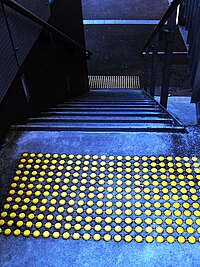
Photo from wikipedia
Proprioception, the sense of limb position and motion, is essential for generating accurate movements. Limb position sense has typically been studied under static conditions (i.e., the fixed position of a… Click to show full abstract
Proprioception, the sense of limb position and motion, is essential for generating accurate movements. Limb position sense has typically been studied under static conditions (i.e., the fixed position of a limb in space), with less known about dynamic position sense (i.e., limb position during movement). Here we investigated how a person's estimate of hand position varies when using spatial or temporal information to judge the unseen hand's location during reaching. We assessed the acuity of dynamic position sense in two directions, orthogonal to hand movement, which only requires spatial information, and in line with hand movement, which has both spatial and temporal components. Our results showed that people have better proprioceptive acuity in the orthogonal condition where only spatial information is used. We then assessed whether cerebellar damage impairs proprioceptive acuity in both tasks during passive and active movement. Cerebellar patients showed reduced acuity in both tasks and in both movement conditions relative to age-matched controls. However, patients' deficits were most apparent when judgments of active movement relied on temporal information. Furthermore, both cerebellar patient and control performance correlated with the trial-to-trial variability of their active movements: subjects are worse at the proprioceptive tasks when movements are variable. Our results suggest that, during active movements, proprioceptive acuity may be reliant on the motor system's ability to predict motor output. Therefore, the resultant proprioceptive deficits occurring after cerebellar damage may be related to a more general impairment in movement prediction.NEW & NOTEWORTHY We assessed limb position sense during movement in patients with cerebellar damage and found deficits in proprioceptive acuity during both passive and active movement. The effect of cerebellar damage was most apparent when individuals relied on both timing and spatial information during active movement. Thus proprioceptive acuity during active movements may be reliant on the motor system's ability to predict motor output.
Journal Title: Journal of neurophysiology
Year Published: 2017
Link to full text (if available)
Share on Social Media: Sign Up to like & get
recommendations!